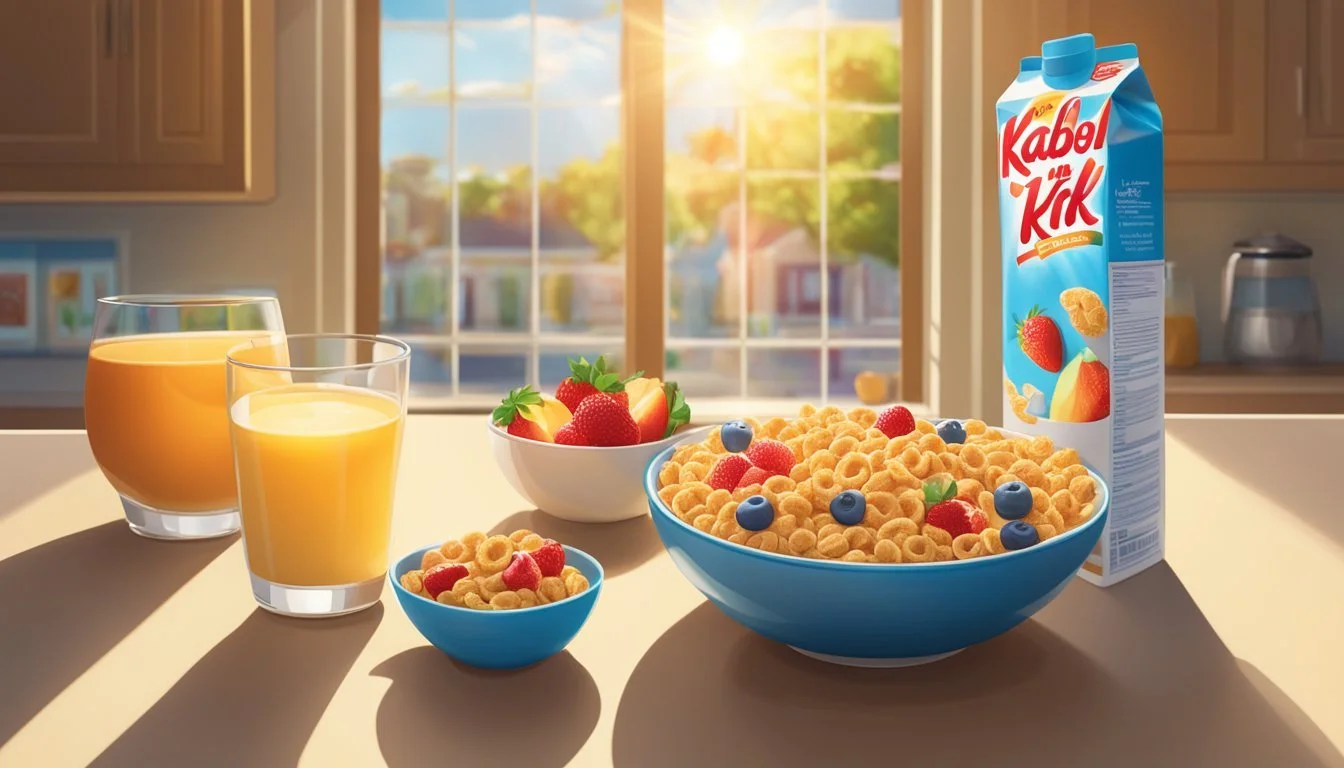Kaboom vs Special K
Comparing Nutritional Value and Taste
This Article is Part of Our Breakfast Cereal Guide with Details on Kaboom Nutrition and Special K Nutrition
When it comes to choosing a nutritious breakfast cereal, the debate between Kaboom and Special K can be quite engaging. Special K, a product of Kellogg's, is known for its health-conscious formulation and practicality. Made from rice, wheat, and barley, it offers a convenient meal choice for those looking to control their diet.
Kaboom, on the other hand, has been a beloved option, particularly among families with children, due to its colorful appearance and sweet taste. Though its nutritional profile leans more towards satisfying a sweet tooth than providing a balanced meal, it still enjoys a special place at the breakfast table.
For those who prioritize nutritional value, Special K remains the preferable option with its controlled portions and balanced ingredients. Comparing the nutritional aspects of both cereals underlines the variation in sugar content and fiber, where Special K generally offers a healthier choice. The contrast between these two options highlights the diversity in breakfast cereals, catering to different tastes and dietary needs.
Overview of Kaboom and Special K
Kaboom and Special K are two distinct products in the realm of food and entertainment. Kaboom is known for its sports card inserts, while Special K is a popular cereal brand from Kellogg's. Each has a unique history and variety to offer.
History and Brand Overview
Kaboom is a highly sought-after sports card insert series produced by Panini. These inserts are renowned for their rarity and distinctive design, featuring comic book-style art. This product often appears as a case hit, meaning a single Kaboom card might be found per case of sports cards, making them valuable among collectors.
Special K is a well-established cereal brand from Kellogg's, first introduced in 1955. It was primarily marketed as a low-fat, high-protein breakfast option aimed at health-conscious consumers. The brand has since expanded its appeal with various products beyond the original cereal, including snack bars and protein shakes.
Product Varieties and Flavor Profiles
Kaboom card inserts include a wide range of sports, featuring athletes from football, basketball, and other major sports leagues. Each series typically has around 20 different cards, and the rarity of these cards often makes them highly prized in the collector community.
Special K offers various product types and flavors to cater to different tastes and dietary needs. Cereal varieties include:
Original
Red Berries
Chocolatey Delight
Fruit & Yogurt
Snack options encompass:
Protein Bars
Breakfast Sandwiches
Shakes
Flavor profiles for Special K products generally combine corn and rice with additional ingredients like fruits and nuts to enhance taste and nutritional value.
Nutritional Comparison
Kaboom and Special K cereals offer distinct nutritional profiles. This section breaks down their key differences in calories, macronutrients, vitamins, and sugars.
Calories and Macronutrients
Kaboom: 110 calories per 30g serving
Special K: 118 calories per 30g serving
Macronutrient Breakdown (per 30g serving):
Kaboom Special K Protein 2g 6g Total Fat 1g 0.4g Carbohydrates 24g 25g Sugars 12g 4.5g Fiber 1g 0.7g
Special K offers higher protein content, while Kaboom contains more sugar. Both cereals have a similar calorie count, but their macronutrient compositions differ significantly, with Special K having less fat and slightly more carbohydrates compared to Kaboom.
Vitamins and Mineral Content
Key Vitamins and Minerals (per serving):
Kaboom Special K Vitamin A 20% DV 15% DV Vitamin C 25% DV 35% DV Vitamin E 15% DV 10% DV Iron 25% DV 45% DV Folic Acid 50% DV 100% DV Calcium 15% DV 2% DV Potassium - 10mg Riboflavin 20% DV 25% DV
Kaboom and Special K are fortified with essential vitamins and minerals. Special K stands out with higher iron and folic acid content. Conversely, Kaboom provides more calcium. Both cereals support daily vitamin intake but may cater to different nutritional needs based on their specific vitamin and mineral offerings.
Added Sugars and Dietary Fiber
Added Sugars Comparison:
Kaboom: 12g per 30g serving
Special K: 4.5g per 30g serving
Dietary Fiber:
Kaboom: 1g per 30g serving
Special K: 0.7g per 30g serving
Kaboom contains significantly more added sugars than Special K, making it less favorable for those monitoring sugar intake. In terms of dietary fiber, both cereals offer limited amounts, with Kaboom having a slight edge. Special K's lower sugar content aligns better with FDA recommendations for daily sugar intake.
Health and Diet Considerations
Balancing health and diet is crucial when choosing between Kaboom and Special K cereals. This section focuses on nutritional values, weight management, and dietary restrictions.
Importance of Balanced Breakfast
A balanced breakfast sets the tone for the rest of the day. Special K offers a lower calorie count, with around 120 calories per cup plus 40-75 calories if milk is added. Kaboom provides slightly higher calorie content per serving but includes a more diverse range of vitamins and minerals.
Special K includes protein, primarily from the added milk, and is made from rice, wheat, and barley. It provides a boost in the morning but lacks significant fiber. Kaboom, on the other hand, incorporates some fiber and higher levels of vitamins like A, C, D, and calcium.
Impact on Diet and Weight Management
Special K is well-known for the Special K Challenge, claiming weight loss benefits by replacing two daily meals with their products. This diet is designed for short-term weight management, generally lasting 14 days. Its low calorie content (160-215 total per meal) makes it a popular choice for those wanting to reduce calorie intake quickly.
Kaboom, being higher in sugar content, might not be ideal for strict weight management plans. The low fat content in both cereals ensures that they are heart-healthy options, yet users should monitor portion sizes. Special K's low sodium levels make it a heart-friendly choice compared to many other breakfast cereals.
Special Diets and Allergen Information
Special diets such as gluten-free or low-sugar might not find either of these cereals suitable without modifications. Special K contains grains like wheat and barley, making it unsuitable for people with gluten intolerance. Kaboom also contains allergens such as wheat, which might pose issues for those sensitive to gluten.
Both cereals are made without peanuts or tree nuts, often making them safe for those particular allergies. However, it's critical to check specific packaging for allergen statements. People on a vegetarian diet will find Special K suitable, especially when paired with plant-based milk options.
Overall, while both cereals cater to specific dietary needs, understanding their nutritional content helps determine the best fit for personal health goals.
Consumer Information
Consumers seeking information on Kaboom and Special K should consider price, cost-effectiveness, packaging, serving sizes, and availability. These factors are essential in making informed decisions about both products.
Price and Cost-Effectiveness
Special K products are notably inexpensive. A typical 11.2-ounce box of Special K cereal often retails for less than $5, making it a cost-effective option for those on a budget. Comparatively, Kaboom cleaning products vary in price. For example, a single bathroom spray bottle might be priced around $4 to $6, depending on the store and specific product. Both products offer value for their intended purposes, whether for dietary needs or cleaning necessities.
Packaging and Serving Sizes
Special K cereals generally come in packages of about 11.2 ounces, with each serving weighing approximately 1.5 ounces. This translates to roughly 7.5 servings per box, assuming standard serving sizes. Kaboom products are typically sold in various forms like sprays or foams, with packaging designed for convenience in household cleaning. The packaging and serving sizes for both products are suitable for their respective uses, aligning well with consumer needs.
Availability and Purchase Locations
Special K cereals are widely available, found in most supermarkets, grocery stores, and online retailers. This broad distribution makes it easy for consumers to purchase Special K products almost anywhere. Kaboom cleaning products are also readily available in numerous locations, including major retail stores, hardware stores, and online platforms. Both products' wide availability ensures that consumers can purchase them without difficulty, adding to their appeal.
Analysis and Ratings
Both Kaboom and Special K have distinct characteristics that shape their consumer ratings and competitive standing. Analyzing consumer feedback, comparing them with other brands, and giving recommendations for when each might be best consumed provides clearer insights.
Consumer Ratings and Feedback
Kaboom has garnered mixed reviews due to its sugary profile and vibrant appeal targeted at children. Parents appreciate the nostalgic factor but express concerns about its high sugar content. Rating: 3.5/5
Special K, in contrast, is praised for its health benefits, especially among those seeking weight management options. Its variety of flavors and formulations (like protein-enhanced versions) has broadened its appeal. Rating: 4.2/5
Key Points:
Kaboom: Fun appearance, high sugar content.
Special K: Nutritional benefits, multiple flavors.
Competitive Comparison with Other Brands
Kaboom is often compared with other sugary cereals like Froot Loops and Cap’n Crunch. It stands out for its unique star shapes and colors. However, it faces criticism for being less nutritional compared to competitors.
Special K’s competitors include cereals like Cheerios and Fiber One. Distinctive for addressing dietary needs, Special K offers better alternatives for those mindful of calorie intake. Besides, it integrates easily into different meal plans, unlike its more sugary peers.
Key Points:
Kaboom: Appeals to children, lower nutritional value.
Special K: Dietary support, versatile consumption.
Recommendations for Consumption
Kaboom is best enjoyed as an occasional treat given its high sugar content. It may not be the healthiest option, but it does offer a fun breakfast experience for children. Restricting it to occasional consumption helps mitigate dietary concerns.
Special K is recommended for daily consumption by those focusing on a balanced diet. Whether it's the original version, protein shakes, or snack bars, Special K accommodates a variety of eating habits. Especially beneficial for breakfast, it ensures a nutritious start to the day.
Key Points:
Kaboom: Enjoy as a treat.
Special K: Suitable for regular, health-conscious diets.






